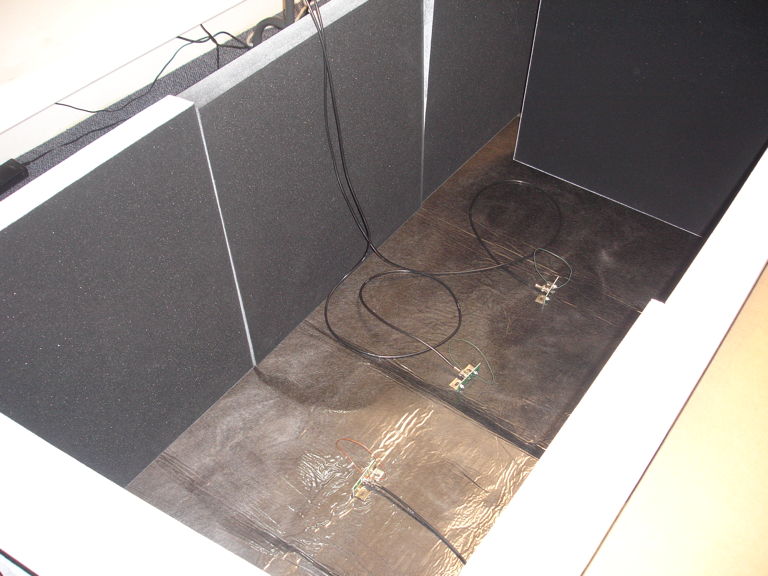
Figure: Coffin-Like Absorbing Enclosure. Floor is reflecting sheet, walls are AN-77 absorbers.
The purpose of any chamber we might build around our SCT system is to promote reliable reception. The chamber can do this in two ways. One is to attenuate external interference. Another is to increase the power we receive from our transmitters. Our new Data Receiver (A3027) provides eight independent antenna inputs. Each has its own amplifier, demodulator, and message detector circuit. With eight antennas, we need only one to pick up a transmitter message. An isolation chamber with one or two reflecting walls can make it more likely that a message will be received by an antenna 100 cm away.
In the coffin-like enclosure shown above, we see three antennas on the floor. These are each independent and connected to our prototype A3027. They are separated by 30 cm, which is enough for a rat cage. We hold an A3019D transmitter in our hand, with the antenna protruding into air, and move and rotate it at random in the 30-cm cube between the left and center antenna. We obtain 100.00% reception over one minute. That is to say: we do not lose a single message. If we disconnect the right-most antenna, reception drops to 98.2%, and if we disconnect the left-hand antenna as well, reception drops to 96.6%. We perform the same measurements with the entire transmitter and antenna enclosed in our hand, so the antenna is enclosed in human tissue at least 2 cm deep. We connect all three antennas. We obtain 99.3% reception. We remove the enclosure and repeat our measurement with only the center antenna connected, and the transmitter in our fist. We obtain 38% reception.
Interference power in our office is −48 dBm, which is as great as we have seen in any laboratory. Reception with one antenna at ranges up to 30 cm is only 38% when we mimic implantation by holding the transmitter in our fist. With three antennas inside our coffin-like absorbing enclosure, however, reception rises to 99.3%.
The dramatic improvement in reception is provided by the slight attenuation of external interference provided by the absorbing walls of the coffin. But it is also provided by the reflection of radio-waves towards the more distant antenna by the floor of the enclosure. Within the chamber, we are more likely to pick up signals with the distant antenna than outside.
Thus we propose to place a wall of absorbers behind and to either side of an IVC rack, a curtain of conducting mesh fabric in front, and a mat of conducting fabric below. These precautions, when combined with eight independent receiving antennas, may give us reliable reception inside the rack.
Now suppose we have two such racks in one room. Our absorbing enclosure will not guarantee that the antennas in one rack will not pick up signals from the other rack. Reception from the neighboring rack may be poor and rare, but it cannot be stopped entirely. Thus we must add one more feature to our SCT system. We propose that new transmitters broadcast a set number between 1 and 15 after their existing message bits. Meanwhile, we will be able to configure our A3027 data receivers so that they reject messages from all but one set number. Thus we can operate transmitters with set number 1 in an IVC rack next to transmitters with set number 2. The transmission of the set number will come at a slight cost in current consumption: battery life will drop by roughly 10%.
The scheme we have described has the advantage of being far more practical than the original sealed and reflecting faraday enclosure. We merely hang walls of absorbers around the back and sides of the rack. We have a curtain that can be pulled aside from the cages in front. We do not have to seal any gaps. Our multiple antennas and the transmitter set numbers provide reliable reception at the same time as stopping cross-talk between adjacent SCT systems. Our hope is to test this scheme at ION at the end of October.
No comments:
Post a Comment